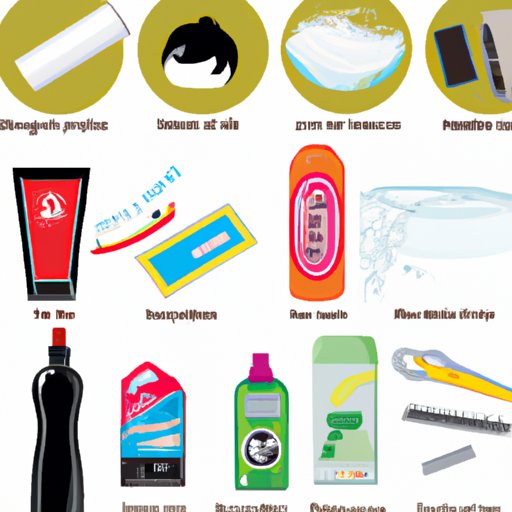Introduction
Hair glue is an adhesive product used to attach extensions, wigs and other products to the hair. It is a strong and long-lasting glue, but it can also be difficult to remove. Common problems associated with removing hair glue include scalp irritation, hair breakage and damage to the hair follicles.
Using a Clarifying Shampoo
One of the easiest ways to remove hair glue from your hair is by using a clarifying shampoo. Clarifying shampoos are specifically designed to remove build-up from the hair, including hair glue. They are gentle on the hair and scalp and can help to reduce scalp irritation caused by hair glue.
When using a clarifying shampoo, make sure to follow the instructions on the packaging. Generally, you will need to wet your hair, apply the shampoo, massage it into the scalp and leave it on for a few minutes before rinsing. Depending on the type of hair glue, you may need to repeat this process several times.
Applying Olive Oil
Another effective method for removing hair glue is to apply olive oil. Olive oil is a natural lubricant that helps to loosen the bonds between the hair and the hair glue. It is also rich in antioxidants, which can help to protect the hair against further damage.
To use olive oil, simply apply a small amount to the affected area, then gently massage it into the scalp. Leave the oil on for around 10 minutes, then rinse it out with warm water. You may need to repeat this process several times for best results.
Washing with Hot Water
Hot water can also be used to help remove hair glue from the hair. The heat from the water helps to break down the glue, making it easier to remove. It’s important to note that hot water can cause further damage to the hair, so it should only be used as a last resort.
To use hot water, fill a bowl or basin with very hot water and submerge the affected area in the water. Leave it in for several minutes, then gently massage the area to help loosen the glue. Rinse the area with cool water afterwards.
Massaging with Baking Soda
Baking soda is another effective method for removing hair glue. Baking soda is a mild abrasive, which helps to break down the glue and make it easier to remove. It is also non-toxic, so it is safe to use on the skin and hair.
To use baking soda, mix it with a small amount of water to form a paste. Apply the paste to the affected area, then gently massage it into the scalp. Leave it on for a few minutes before rinsing it out with warm water.
Rubbing with a Dryer Sheet
Dryer sheets can also be used to help remove hair glue from the hair. The fabric softener in the sheets helps to break down the bonds between the hair and the glue, making it easier to remove. It is important to note that dryer sheets should not be used on colored or permed hair, as they can cause further damage.
To use a dryer sheet, wet the affected area with warm water. Then, rub the dryer sheet over the area until the glue starts to loosen. Rinse the area with warm water afterwards.
Applying a Solvent-Based Adhesive Remover
If all else fails, a solvent-based adhesive remover can be used to remove hair glue from the hair. These products are specifically designed to break down the bonds between the hair and the glue. However, they can be harsh on the hair, so it is important to use them sparingly.
To use a solvent-based adhesive remover, apply a small amount to the affected area. Gently massage it into the scalp, then leave it on for a few minutes before rinsing it out with warm water. Repeat this process if necessary.
Conclusion
Removing hair glue from your hair can be a challenging task. However, with the right techniques and products, it is possible to safely and effectively remove the glue. To remove hair glue, try using a clarifying shampoo, applying olive oil, washing with hot water, massaging with baking soda, rubbing with a dryer sheet or applying a solvent-based adhesive remover. With these steps, you should be able to successfully remove the hair glue and restore your hair to its original state.


